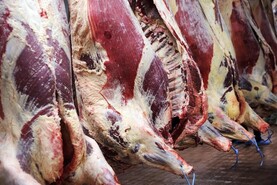The cattle kill failed to break 30,000 again last week, having fallen below in the previous short working week because of the bank holiday.
The final number of 29,653 head is well down on the 32,490 that went through the factories in the same week in 2023, with the poor spring weather being blamed for a slowness in cattle coming off grass.
The steer kill in particular was down almost 2,000 head at 9,423, compared with 11,392 in the same week last year.
Despite the recent slowdown, the total factory kill for the year to date is still ahead of last year, up 11,534 head at 812,584, reflecting the strong throughput earlier in the year.
All this means that there has been a strong kill of cattle out of sheds, as many feeders couldn’t get them out and recent cold weather has slowed grass growth.
On the demand side, the arrival of better weather is likely to give the steak trade a boost, while the Euros will help burger demand across the continent.
With England being such a large market for our exports, beef producers should be cheering England all the way to the final!
All of this means that factories are having to work to secure cattle supplies and are likely to have to keep working in coming weeks, even if they struggle to get much more from the market place.
Quotes
Quotes for steers and heifers are in general up 5c/kg on last week, with €5.20/kg widely available for steers and €5.25/kg for heifers.
With factories chasing, better deals may be secured for large lots of cattle that press the specification buttons, while, at the other end, some factories may be trying to hold prices for smaller lots that come their way.
The cow trade is also strong, with exceptional U grading cows easily getting €5.10/kg, while R grading ones are making up to €4.90/kg.
Where real strength has came into the market is for plainer well-fleshed cows.
O- grades with flesh will get up to €4.60/kg and O+ grades can get up to €4.70/kg, while P+3 grading cows are making comfortably above €4/kg and going as far as €4.30/kg, but they must have flesh.
Very thin cows without any finish aren’t wanted in factories and for them it is a case of taking what you get, with prices often closer to €2/kg than €3/kg.
A sign of the strong demand for cows is that factory agents have been particularly active in marts to top up supplies.
Young bulls are also a strong trade, with U grading bulls making up to €5.50/kg, R grading between €5.30/kg and 5.40/kg and there is good demand for plainer young bulls that are well covered, with €5.10/kg to €5.20/kg being paid.
Northern trade
Official quotes remain on £4.60/kg to £4.68/kg (€5.74/kg to €5.84/kg inc vat) for U-3 steers and heifers, but, in practice, more is available in the real market, with deals being made above £4.80/kg (€5.99/kg inc vat) for steers and heifers.
O+3 cows are officially quoted at £3.30/kg to £3.56/kg (€4.11/kg to €4.44/kg inc vat), but, again, more is available.
As is the case south of the border, mart trade is very strong and a real option for farmers with small numbers that may be in a weaker negotiating position at the factory gate.
Prices rise in Britain
After prices slipping over recent weeks in Britain, there was a slight upturn in steer price last week as throughput fell by 5% on the week before.
The average steer price across all grades was £4.48/kg, the equivalent of €5.96/kg when vat is included. For heifers, the average was marginally lower at £4.76/kg, the equivalent of €5.94/kg when vat is included with throughput also down by 4.6% on the week. Average cow price across all types was fractionally lower at £3.61/kg, which is the equivalent of €4.50/kg vat included.






 This is a subscriber-only article
This is a subscriber-only article










SHARING OPTIONS: